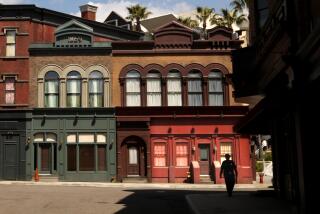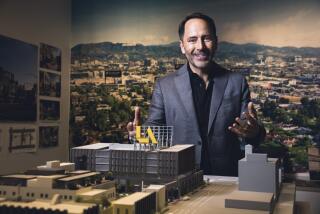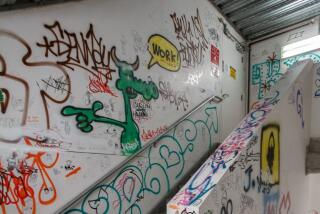ARCHITECTURE : CBS Television’s ‘Glass Box’ Has Naked Power, Surprising Beauty
CBS Television should be a bad building. It is a huge hulk, out of scale with anything around it. Nearly windowless and anonymous, it gives almost no hint of what goes on inside. To top it off, it sits back from the busy streets it should front, leaving a sea of parking to distance it from Fairfax Avenue and Beverly Boulevard.
Yet the building has a power, clarity and even beauty that so far surpasses the bland boxes that face the street that its standoffish presence actually makes it one of the strongest landmarks of the Beverly-Fairfax neighborhood.
Basically, though, this is a building that could be anywhere. Its core is a four-story cube of glass and steel fronting a sweep of lawn, giving Television City the illusion of belonging in some verdant suburban office park.
The centerpiece is quite a beautiful cube, though, as close to the ideal of an abstract, machined architecture as you’ll find in these parts. Designed by Los Angeles’ greatest modernist, William Pereira, in 1952, it represents the refined and optimistic aesthetic of that era. The corners are glass, allowing the grid to seem open-ended. The glass itself is clear, and the building floats on unseen columns behind the bermed lawn.
What undercuts this little bit of Modernist perfection is the fact that the transparent office core is overshadowed by the massive concrete and corrugated metal studio buildings that are jammed right onto it. To the west, the main bulk of the studio is housed in a giant, white-painted box that was enlarged in 1976. The only way into this mass is a slot of black-painted steel and bronze glass that faces Fairfax. To the east, something called “Robertson decking,” a clip-on metal paneling system, hides untold mysteries in a more confused set of rectangular additions that eventually detach themselves from the building and become a long line of carpenter sheds.
The only thing tying these disparate forms together is a second-story walkway that starts life as a metal bridge leading from the raised drop-off ramp running parallel to Beverly Boulevard.
The bridge, a set of black steel forms shot through with red-painted railings, zooms past the cube, allowing you to slide in around its corner, then becomes a kind of balcony that skirts the whole north, west and south sides of the building. To the west, it provides a sheltered colonnade below for the public waiting for admission to tapings. It also provides a visual base for the otherwise unformed buildings. This snaking connector makes you aware of the subtleties of the site planning. It gives the executives a grand entrance, while screening their cars in a kind of moat hidden behind the bermed lawn, and then allows the public to enter through a grand forecourt of parking dominated by the large forms of the studios.
The power of Television City in fact turns out to lie in its naked scale and the clear way in which the unavoidable hulks of the inward-turned studios are treated. Neither hidden nor gussied up, they are mute monuments that hold their own against the confusion of the city. The 1976 addition seems to have overplayed the scale a bit, though, while later expansions have filled in the cracks between buildings with unsightly additions that detract from this clarity. Now Television City is planning to expand even further to the east, promising the final dissolution of Pereira’s clear vision into a formless sprawl. For now, the grandeur of the golden age of television and all of its promises of a better, more rational world can still be found caught in the glass box. This is not a friendly, gentle dream of a building, but its vision cannot be denied.
More to Read
The biggest entertainment stories
Get our big stories about Hollywood, film, television, music, arts, culture and more right in your inbox as soon as they publish.
You may occasionally receive promotional content from the Los Angeles Times.










